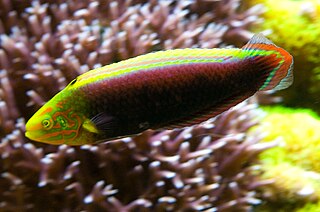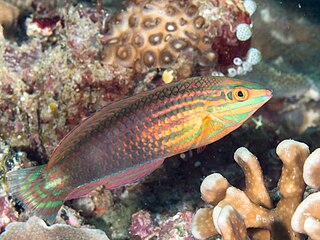
The slippery dick is a species of wrasse native to shallow, tropical waters of the western Atlantic Ocean.

The checkerboard wrasse is a fish belonging to the wrasse family. It is native to the area including the Indian Ocean to central Pacific Ocean.

The bar jack, also known as the carbonero, red jack, blue-striped cavalla or passing jack, is a common species of inshore marine fish classified in the jack family, Carangidae. The bar jack is distributed through the western Atlantic Ocean from New Jersey and Bermuda in the north to Venezuela and possibly Brazil in the south, with the largest population in the Gulf of Mexico and West Indies. The bar jack is most simply distinguished from similar jacks by its dark horizontal bar which runs along the back and down the caudal fin, often accompanied by an electric blue stripe immediately below it. Other more detailed differences include dentition and soft ray counts. The bar jack is a moderately large species, growing to a recorded maximum of 65 cm and a weight of 6.8 kg. The species inhabits clear shallow waters, often over coral reefs where it lives either solitarily or in large schools, taking various fishes, crustaceans and cephalopods as prey. Studies in Cuba indicate spawning occurs between March and August, with sexual maturity reached at 26 cm. It is a relatively popular sport fish and can be caught on light tackle with a variety of lures and baits. It is considered to be a good food fish, however many recorded ciguatera cases are attributed to the species, with most cases reported on the island of St. Thomas traced to this single species.
The whip-fin wrasse is a species of wrasse endemic to Indonesia, where it is only known from the waters of the Java Sea. This species inhabits reefs and can be found at depths from 10 to 35 m. It can reach 8 cm (3.1 in) in total length. Both its common name and its specific name refer to the long filament extending from the tenth and eleventh rays of the dorsal fin.
The triplespot wrasse, also known as the white wrasse, is a species of wrasse native to the western Indian Ocean from South Africa to the Maldives and Mauritius. This species prefers areas of sandy substrates around reefs and can be found at depths from 15 to 56 m. It can reach 9.5 cm (3.7 in) in total length.

Halichoeres iridis is a species of wrasse native to the western Indian Ocean along the African coast and nearby islands. It can be found in areas of rubble and sand around reefs at depths from 6 to 43 m. This species can reach 11.5 cm (4.5 in) in total length. It can be found in the aquarium trade.

The tail-spot wrasse, Halichoeres melanurus, is a species of wrasse in the western Pacific from Japan to Samoa and Tonga and south to the Great Barrier Reef. This species is found along rocky shores or on coral reefs at depths from 1 to 15 m. It can reach 12 cm (4.7 in) in total length. This species is popular for display in public aquaria and can be found in the aquarium trade.

The pastel-green wrasse, also known as the black-blotched rainbowfish, black=blotched wrasse, dark-blotch wrasse or green-spotted wrasse, is a species of wrasse native to the central western Pacific Ocean. It can be found on coral reefs and the surrounding areas at depths from the surface to 10 m (33 ft). Its coloration varies depending upon the habitat in which it occurs, ranging from bright green in fish living in areas with heavy algal growth to pale or with dark bars for those inhabiting rubble areas. This species can reach 19 cm (7.5 in) in standard length. It is of minor importance to local commercial fisheries and can be found in the aquarium trade.
The longfin fairy wrasse, also known as the social wrasse, is a species of wrasse from the western Indian Ocean from the Red Sea to South Africa, though questionable claims have been made for its occurrence out to the western Pacific. It inhabits coral reefs at depths of 3 to 43 m. This species can reach a total length of 7.5 cm (3.0 in). It can be found in the aquarium trade.

The yellowhead wrasse is a fish species belonging to wrasse family native to shallow tropical waters in the Caribbean Sea and western Atlantic Ocean.

The red-lined wrasse, two-spotted wrasse or biocellated wrasse, Halichoeres biocellatus, is a species of wrasse native to shallow tropical waters in the western Pacific Ocean.

The creole wrasse is a species of wrasse native to the western Atlantic Ocean.

Marjorie's wrasse, Cirrhilabrus marjorie, is a species of wrasse native to the coral reefs of the Fiji. This species can reach a standard length of 5.8 cm (2.3 in). It can be found at depths from 20 to 50 m, most often between 30 and 36 m. The specific name honours Marjorie Awai, the Curator of the Florida Aquarium, and who was formerly a Curatorial Assistant in the ichthyology Department at the Bishop Museum in Hawaii.

The nebulous wrasse is a species of wrasse native to the Indian Ocean and the western Pacific Ocean. It can be found in groups at depths from 1 to 40 m on reef flats. This species feeds on fish eggs and benthic invertebrates, including crabs, sea urchins, ophiuroids, polychaetes, sponges and mollusks. Its coloration varies, ranging from brown to dark green. This species can reach 12 cm (4.7 in) in total length. It can be found in the aquarium trade.

Halichoeres maculipinna, the clown wrasse, is a species of tropical fish that lives throughout the Caribbean Sea and adjacent parts of the western Atlantic Ocean. It is a carnivorous, multi-colored wrasse that is common throughout its range.

Halichoeres leucoxanthus, commonly called the Canarytop wrasse, Whitebelly wrasse, or Lemon meringue wrasse, is a fish species in the wrasse family endemic to the Indian Ocean.

Halichoeres prosopeion, commonly called the twotone wrasse, half-grey wrasse or zig-zag wrasse, is a fish species in the wrasse family native to the western Pacific Ocean.
Halichoeres richmondi, commonly called the Richmond's wrasse or chain-lined wrasse, is a fish species in the wrasse family native from the central Indo-Pacific.

Halichoeres scapularis, commonly called the Zigzag wrasse , is a fish species in the wrasse family native from the Indo-West Pacific.

The blackear wrasse is a species of wrasse, a type of fish in the family Labridae, from the warmer waters of the western Atlantic Ocean.

















